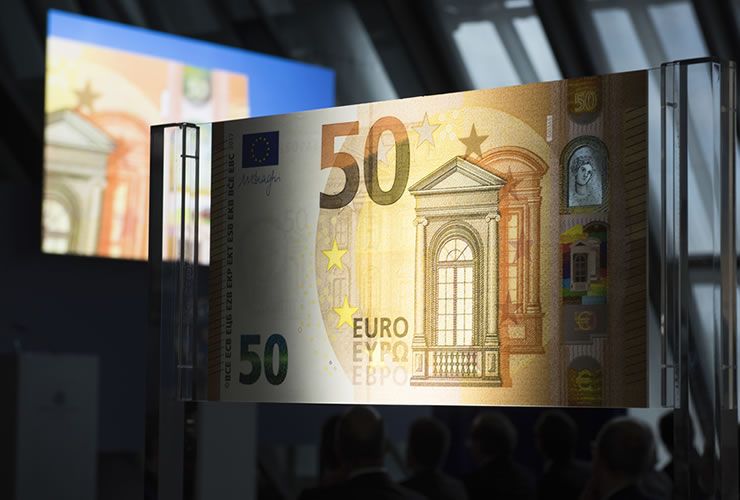EUR/USD: Chart Hints at Further Downside

The chart of the Euro-to-Dollar exchange rate is looking extremely bearish at the start of the new trading week.
Our observations confirm EUR/USD has formed a compelling topping reversal pattern called a head and shoulders (H&S) top, a development that advocates for further potential downside over coming days.
The pattern suggests the broader uptrend enjoyed by the Euro for much of 2017 is probably in the process of reversing and starting a new downtrend, which could take the exchange rate substantially lower.
Head and shoulders patterns are formed of three peaks after a strong up-move:

The middle peak is the tallest and represents the 'head' whilst the two peaks either side of it, which are lower, represent the 'shoulders'.
The line below the pattern constructed by joining the two intervening troughs is called the neckline.
When the exchange rate has finished forming and it breaks below the neckline that provides the confirmation needed to expect the decline to begin.
This has already happened on EUR/USD but the exchange rate then pulled back immediately after breaking down, in what is commonly called a throw-back move, which is a brief pull-back to the neckline after a break (red line on chart).
The throw-back is only a temporary recovery before the downside breakout move resumes and the exchange rate starts to decline more forcefully.
For confirmation the decline has started again we would first want to see a break below the October 27 lows of 1.1575.
Normally the fall from an H&S is equal to the height of the pattern from the peak of the head to the neckline extrapolated from the neckline lower.
This gives an eventual downside target of 1.1255, however, in this case we think the eventual target will probably actually be slightly higher at 1.1275, just above the level of the 200-day moving average (MA) at 1.1268, because it is such an important support line that the exchange rate often either stalls or reverses when it touches it.
On the way down there are further minor targets to consider at the levels of the S1 and S2 monthly pivots at 1.1525 and 1.1400 respectively.
Pivots are also likely to present obstacles to further downside, as they are levels on charts which attract increased demand due to traders using them to counter-trend trade in anticipation of the pull-backs and bounces which often occur after the exchange rate has touched them.
Finally, the MACD momentum indicator is adding bearish evidence to the chart as it is making new lows.
Get up to 5% more foreign exchange by using a specialist provider by getting closer to the real market rate and avoid the gaping spreads charged by your bank for international payments. Learn more here.
Events and Data to Watch for the Euro
Politics could be a mover of the Euro in the week ahead although the main flash-points are regional thus probably won't cause substantial levels of volatility for the single currency.
Regional elections in Sicily on Sunday are being presented as a dress rehearsal for the bigger Italy-wide elections in May 2019, and therefore, could be a barometer to suggest their outcome.
To effect a move in the Euro, Sicily would have to vote overwhelmingly for the anti-EU Five Star party, yet in actual fact, exit polls appear to favour former centre-right prime minister Silvio Berlusconi winning instead.
Election rules were changed recently making it harder for one party to achieve outright rule and given Five Star refuses to form coalitions with any other parties it is unlikely to gain power and threaten to take Italy out of the EU.
Catalonia's bid for independence appears to have been snuffed out after Madrid introduced direct rule and dissolved the Catalan regional government.
Arrest warrants have now also been issued for the top players in the Catalan parliament, including president-in-exile Carles Puigdemont.
Whilst the crisis in Catalonia appears to have eased, there is still the potential for outbreaks of protest or surprise twists and turns in the tale, but ultimately the chances of that causing major volatility for the Euro are now low.
On the hard data front, the first main release for the Euro in the coming week is Retail Sales at 10.00 on Tuesday, November 7, which is expected to show a 0.6% rise from -0.5% previously.
Apart from that, there is German Industrial Production at 7.00 on Tuesday, November 7, and the final estimate for October Services PMI released on Monday at 9.30.
Data and Events for the Dollar
It's a quiet week for the Dollar after all the drama of the previous week, with the only real tier one release Michigan Consumer Sentiment, for November, out on Friday, November 11 at 15.00 GMT.
Michigan Sentiment is expected to rise to 90.9 (from 90.5) for the expectations component and 101.9 (from 100.7) for the current situation.
The other major Dollar driver investors will be focusing on in the week ahead is the progress of the Tax Reform bill a blueprint of which was drawn up and published last Thursday.
Current expectations are not supportive of an optimistic outlook for the bill which critics say contains too many contentious policies to have any hope of being passed by Congress into law.
The market will be closely watching how debates around the final content of the bill evolve.
Analysts at TD Securities are of the view it will not get voted through until next year:
"The Senate plans to release their version this week, with the goal of passage by Thanksgiving. Areas of contention, pushback from industry groups and questionable deficit impacts will keep uncertainty high for now. We continue to believe tax reform is more likely to be passed early next year."










